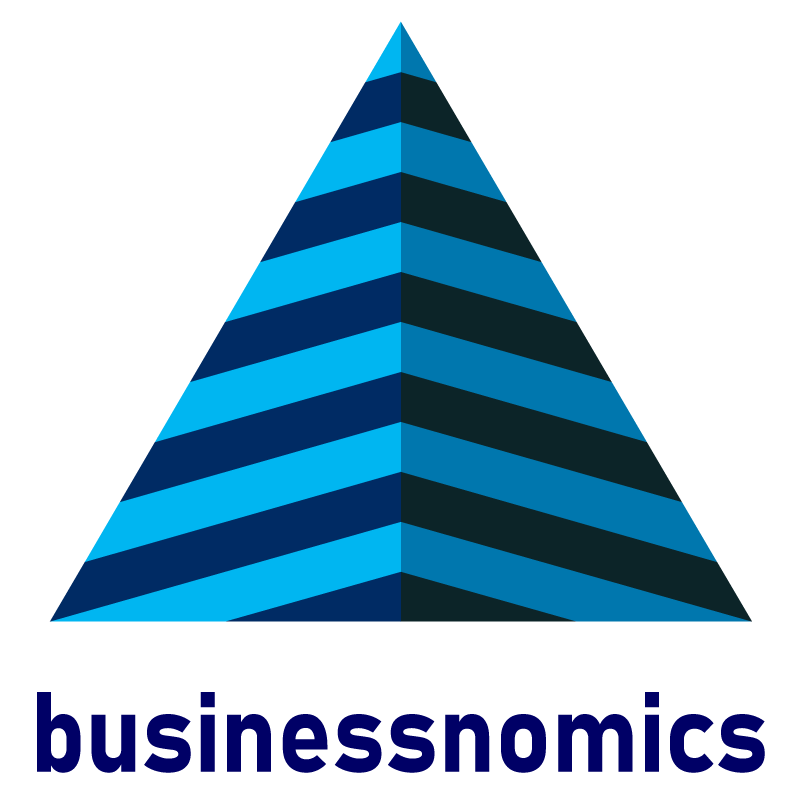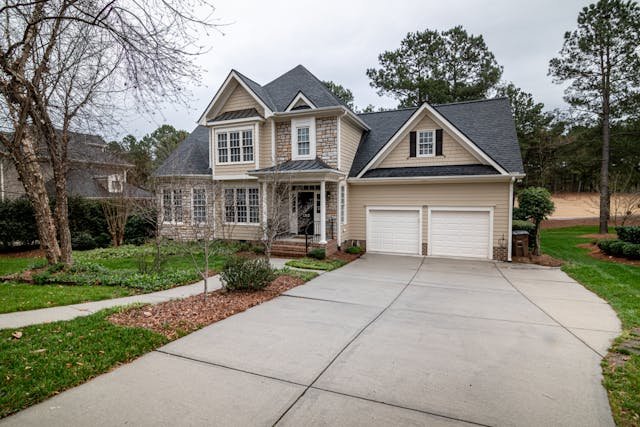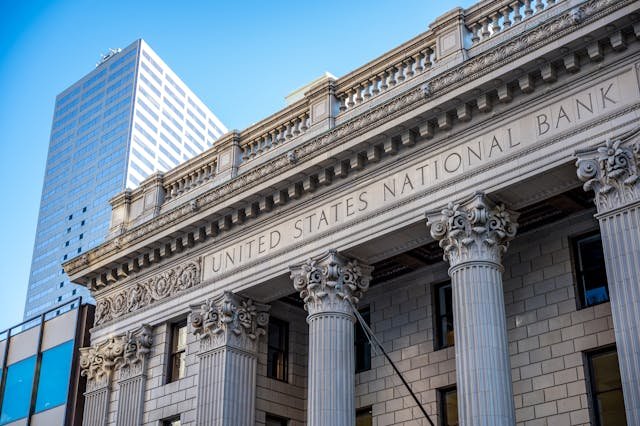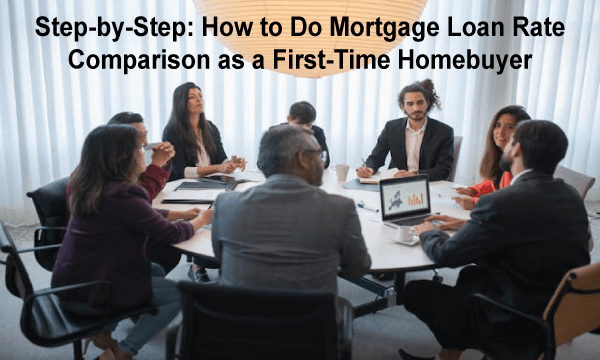Top Secrets on How To Compare Mortgage Rates In the US
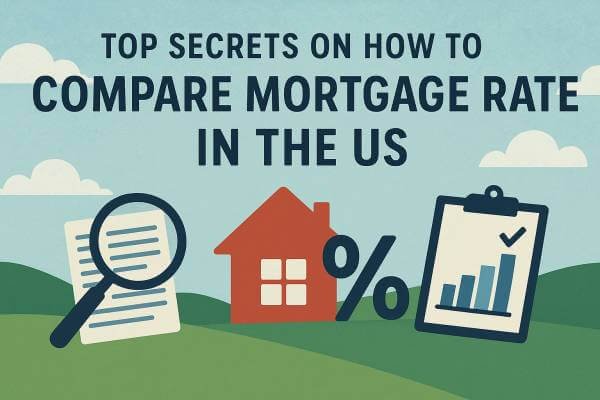
If you’re about to buy a home or refinance, one of the smartest things you can do is compare mortgage rates; don’t skip this step. A small difference in rates could mean saving (or losing) thousands of dollars over the life of your loan.
But with so many lenders, terms, and flashy ads out there, it’s easy to get overwhelmed. Which rate is actually the best? What fees are hiding behind that “low” offer? That’s where this guide comes in.
I’m going to break it all down for you in a simple, clear, and totally beginner-friendly way. Whether you’re a first-time buyer or just looking to refinance smarter, you’ll learn how to shop for rates like a pro, avoid common traps, and feel confident you’re getting the best deal.
What Are Mortgage Rates, and How Are They Set?
Before you start to compare mortgage rates, it’s important to know what you’re actually comparing. Many folks think mortgage rates are just random numbers thrown at them by lenders, but they’re not. There’s a method to do it.
What Is a Mortgage Rate?
Your mortgage rate is the interest a lender charges you to borrow money for a home. It’s expressed as a percentage, and it directly affects how much you’ll pay each month and over the entire loan term.
Here’s a quick example:
Say you borrow $300,000 over 30 years.
With a 6% interest rate, your monthly principal and interest would be around $1,799.
At 7%, that jumps to about $1,996.
That’s nearly $200/month more, or over $71,000 more across 30 years.
That’s why it’s so important to compare mortgage rates carefully and not just accept the first one you’re offered.
How Small Rate Changes Make a Big Impact
| Interest Rate | Monthly Payment | Total Interest Over 30 Years |
| 6.00% | $1,799 | $347,514 |
| 6.50% | $1,896 | $382,633 |
| 7.00% | $1,996 | $418,527 |
Even a 0.5% bump adds $35,000+ in interest over time!
What Determines Your Mortgage Rate?
Mortgage rates are not universally applicable. Lenders look at a bunch of factors when deciding what rate to offer you. Some are personal to you; others are based on the broader economy.
Personal Factors That Affect Your Rate
| Factor | Why It Matters |
| Credit Score | Higher scores = lower risk = better rates. Aim for 700+ to unlock the best offers. |
| Loan Type | FHA, VA, Conventional, and jumbo. All have different guidelines and risk levels. |
| Loan Term | Shorter loans (like 15 years) usually come with lower rates. |
| Down Payment Size | Putting down more money reduces lender risk, which can lower your rate. |
| Debt-to-Income Ratio | Lenders aim to ensure your financial stability. |
Market Factors That Affect Everyone
| Factor | How It Impacts Mortgage Rates |
| Federal Reserve Policy | When the Fed hikes interest rates, mortgage rates tend to rise too. |
| Inflation | High inflation usually pushes mortgage rates up, since lenders want to protect their returns. |
| Bond Market Activity | Mortgage rates are closely tied to the 10-year Treasury yield. |
| Overall Economy | Strong job reports or high consumer spending can signal rate increases. |
Types of Mortgage rates
Basically, there are two main types of mortgage rates. Before you compare mortgage rates, it helps to understand the two basic types of rates:
Fixed-Rate Mortgage
- Your rate stays the same for the entire loan term.
- Monthly payments stay consistent.
- Great if you plan to stay put for a while.
Adjustable-Rate Mortgage (ARM)
- Lower starting rate for the first few years (e.g., 5, 7, or 10).
- Then it adjusts, usually once per year, based on the market.
- This option is more advantageous if you do not intend to reside in the home for an extended period.
| Loan Feature | Fixed-Rate Mortgage | Adjustable-Rate Mortgage (ARM) |
| Starting Rate | Higher | Lower |
| Predictability | High (steady payments) | Low (can change yearly) |
| Long-Term Stability | Strong | Riskier over time |
| Good For… | Staying long-term | Moving or refinancing in a few years |
Mortgage Rate Trends: July 2024 – July 2025
| Date | 30-Year Fixed Rate |
| Jul 3, 2025 | 6.67% |
| Jun 5, 2025 | ~6.85% |
| Apr 3, 2025 | ~6.64% |
| Jan 2, 2025 | ~6.91% |
| Oct 3, 2024 | ~6.12% |
| Jul 2024 | ~6.85% |
Trend overview: Rates hovered around 6–7% for most of the year. They dipped below 6.5% in April 2025, briefly rose around the New Year (peaking at ~6.96%), then edged back down to 6.67% by early July.
Rate Highlights Over the Past Year
- Lowest months: April and October 2024 (~6.1–6.6%)
- Highest stretch: January 2025 (~6.95–7.04%), crossing above 7% in early January money.usnews.com+11ycharts.com+11mortgagenewsdaily.com+11
- Most recent dip: A slow slide to 6.67% by July 3, marking the fifth consecutive weekly decrease. The largest weekly drop since March. freddiemac.com+2themortgagereports.com+2fred.stlouisfed.org+2
What This Means for You
- If you compare mortgage rates now, you’re locking in within a relatively tight and lower range than mid‑year averages.
- Considering historical peaks in early 2025, this could be a good time to lock in, unless you expect a Fed-driven drop later this year.
- Experts forecast rates around 6.4–6.8% through the third quarter, with minor cooling by year-end
When Should You Start to Compare Mortgage Rates?
You’ve decided to buy a home (or refinance). But the question is, when is the right time to compare mortgage rates?
It’s not the moment you start browsing listings on Zillow.
Let’s walk through the perfect timing and why it matters more than most people think.
Why Timing Matters When Comparing Mortgage Rates
Mortgage rates change constantly. They’re tied to market conditions, inflation, bond yields, and other moving parts. So, the rate you see today may change by tomorrow or even later today.
If you start comparing rates too early, they may change before you’re actually ready to apply.
You risk missing out on a good deal or feeling pressured to accept a rate without doing any comparison shopping if you wait too long. The best time to compare mortgage rates is when you’re financially ready to move forward, rather than just casually browsing.
Best Times to Compare Mortgage Rates
| Homebuying Stage | Should You Compare Rates? | Why or Why Not |
| Just browsing homes online | ❌ Not yet | You don’t have your budget, credit score, or pre-approval lined up. |
| Pre-approved by a lender | ✅ Yes | You know your price range and can get accurate quotes based on real numbers. |
| Home under contract | ✅ Absolutely | This is go-time. You’ll need to lock your rate before you close. |
| Refinancing | ✅ Yes | You’re likely already qualified, and lenders can give you exact rate comparisons. |
Pro tip: Start comparing mortgage rates seriously after pre-approval, when you’re a real contender in the eyes of lenders.
What’s a Mortgage Rate Lock?
A rate lock is like putting your mortgage rate in a time capsule; it holds your rate steady for a set period, usually 30–60 days, even if market rates go up.
Why Locking In Makes Sense:
- You’re under contract and closing in the next month or two.
- Rates are on the rise, and you want to protect yourself.
- You’ve already compared rates and found one you like.
When to Be Cautious:
- If rates are expected to drop further soon.
- If there is uncertainty or delay in your closing date, you should be cautious.
Some lenders offer a float-down option, which lets you benefit from lower rates if they drop after you lock. Ask about it!
Why Lock Timing Matters & Real-Life Example
Let’s say you’re closing in 45 days and today’s rate is 6.65%. If rates bump up to 6.90% next week and you haven’t locked yet, you just added $50–$100/month to your payment.
That adds up to $18,000+ over a 30-year loan.
| Loan Amount | Rate | Monthly P&I | Total Interest (30 yrs) |
| $350,000 | 6.65% | $2,247 | $458,908 |
| $350,000 | 6.90% | $2,302 | $480,729 |
Economic Signals to Time Your Rate Lock
Rates follow the economy’s lead. Here are the signals you should monitor closely:
| Indicator | What It Means for Rates |
| Federal Reserve Moves | If the Fed raises rates, mortgage rates usually climb. |
| Inflation Reports (CPI) | Higher inflation = higher mortgage rates. |
| Unemployment Data | Weak job reports can put downward pressure on rates. |
| 10-Year Treasury Yield | This closely tracks 30-year mortgage rate trends. |
Pro tip: If the Fed announces a rate hike, don’t panic; mortgage rates often price that in early. But it’s still wise to compare mortgage rates quickly after any big economic news.
Steps to Compare Mortgage Rates Like a Pro
Your mortgage is probably the biggest financial commitment you’ll ever make. So rate shopping is non-negotiable.
Here’s how to compare mortgage rates the smart way, step by step.
Step 1: Get Your Financial Info Ready
Before any lender will give you a solid rate, they need a few key details about your financial situation. This helps them assess your credit risk, which directly affects your rate.
What You’ll Need:
| Document | Why It Matters |
| Credit score (pull it free at Credit Karma or Experian) | Determines your eligibility and best rate tiers |
| Income details (pay stubs, tax returns) | Proves you can afford the loan |
| Debts (car loans, student loans, credit cards) | Used to calculate your DTI (debt-to-income ratio) |
| Loan details (amount, term, type) | Helps lenders match you with suitable products |
Pro Tip: The higher your credit score and the lower your debt, the better your rate. It’s worth spending time improving your score before comparing.
Step 2: Use Trusted Online Tools to Shop Around
The internet makes it super easy to get rate quotes in minutes. Just make sure you’re using reputable platforms, not spammy lead farms.
Here are some excellent places to start:
| Website | Best For | What You’ll See |
| Bankrate | Clear, no-nonsense rate comparisons | Rates based on location and loan type |
| NerdWallet | Great for first-time buyers | APRs, monthly payments, lender reviews |
| LendingTree | Real-time, multiple lender quotes | Offers based on soft credit pull |
| Zillow Mortgages | Home and loan comparison in one spot | See rates while browsing properties |
Step 3: Request Loan Estimates From Multiple Lenders
Once you’ve found a few promising offers, it’s time to get official quotes by asking for a loan estimate.
The Loan Estimate is a 3-page form that shows:
- Your interest rate
- Your APR (more accurate cost)
- Estimated monthly payment
- Upfront costs (like points, fees, taxes)
Why it matters: It’s standardized by law, so you can compare apples to apples between lenders.
Loan Estimate Breakdown Example
| Loan Feature | Lender A | Lender B |
| Interest Rate | 6.50% | 6.35% |
| APR | 6.71% | 6.66% |
| Monthly Payment | $1,896 | $1,869 |
| Total Closing Costs | $7,200 | $9,000 |
| Loan Term | 30 Years | 30 Years |
Compare at least 3–5 loan estimates within a 14-day window. Multiple credit checks count as one on your score.
Step 4: Compare Local vs National Lenders
Big banks aren’t always better. In fact, you might find lower rates or more flexible terms from smaller lenders.
| Lender Type | Pros | Cons |
| National banks | Big brand, wide product range, online tools | Can be slow, less personalized |
| Credit unions | Often lower rates, member-focused | Limited branch network, may require membership |
| Online lenders | Fast, digital, easy comparison shopping | Varies in service and transparency |
| Local mortgage brokers | May shop multiple lenders for you | Might charge additional fees |
Don’t settle. Every lender will make it sound like you’re getting a fantastic deal, but the numbers will show the truth.
Key Features to Compare Besides the Mortgage Rate
The lowest rate doesn’t always equal the best deal. Lenders are smart; they know that if they flash a super low interest rate, most people will stop asking questions.
Other things to compare when shopping for a mortgage so you don’t get burnt by hidden costs later.
1. APR (Annual Percentage Rate)—Your True Cost
APR includes more than just your interest rate. It rolls in lender fees, points, and other charges to give you a more accurate picture of the loan’s real cost.
| Lender | Interest Rate | APR | What It Means |
| Lender A | 6.25% | 6.40% | Slight fees added in |
| Lender B | 5.90% | 6.45% | Lower rate but higher fees = higher real cost |
Tip: Always compare APR to APR, not just interest rate to interest rate.
2. Loan Term—Shorter Loans Save More (But Cost More Monthly)
Do you want a 15-year mortgage or a 30-year one? The difference is massive.
| Loan Term | Monthly Payment | Total Interest Paid | Pros |
| 15-Year | Higher | Much lower | Pay off faster, save big |
| 30-Year | Lower | Much higher | Lower monthly payment, more flexibility |
Example: On a $300,000 Loan
- 15 years at 6% = $2,531/mo, total interest: ~$157K
- 30 years at 6% = $1,799/mo, total interest: ~$347K
→ That’s a $190K difference in interest alone!
3. Discount Points and Origination Fees
Lenders may offer you the chance to “buy down” your rate using discount points, but should you?
| Term | What It Means |
| Discount Points | Prepaid interest. 1 point = 1% of loan. |
| Origination Fees | What the lender charges to process your loan |
Example:
- $300,000 loan
- 1 discount point = $3,000
- May reduce your rate by ~0.25%
Use a mortgage points calculator to see your break-even point (usually ~5–7 years).
4. Closing Costs
Don’t Overlook These Sneaky Charges. Closing costs can range from 2% to 5% of your loan amount.
Common fees to compare:
- Appraisal and inspection fees
- Title insurance
- Processing and underwriting fees
- Escrow and recording costs
Ask for a loan estimate to see these upfront, then compare line by line.
5. Prepayment Penalties and Others
Some lenders charge fees if you pay off your mortgage early. Others bury costs in the small print.
Ask these questions:
- “Can I make extra payments without penalty?”
- “Are there any balloon payments or adjustable terms?”
- “Is this a fixed or introductory rate?”
Mortgage Offer Comparison Checklist
Use this checklist when reviewing multiple Loan Estimates:
- Interest Rate
- APR
- Monthly Payment
- Loan Term
- Discount Points
- Origination & Lender Fees
- Closing Costs
- Prepayment or hidden penalties
Mistakes to Avoid When You Compare Mortgage Rates
There are hidden fees. And there are “low” rates that magically get pricier once you dig into the details. If you want to save money (and frustration), avoid these common pitfalls:
1. Only Looking at the Interest Rate (Not the APR)
This is the #1 mistake. People chase the lowest rate, not realizing that it might be packed with hidden fees, discount points, or short-term gimmicks.
| Loan Offer | Interest Rate | APR | True Cost |
| Lender A | 6.25% | 6.35% | Lower fees, more transparent |
| Lender B | 5.99% | 6.45% | Higher fees are more expensive in the long run |
Always compare APRs; that’s where the real cost lives.
2. Ignoring the Loan Term and Monthly Budget
You might see a 15-year mortgage with a lower rate and think you are saving money. And you are in total interest. But can you actually afford the payment?
Example:
| Loan Type | Monthly Payment | Total Interest Paid |
| 15-Year @ 5.9% | $2,531 | $157,658 |
| 30-Year @ 6.1% | $1,815 | $353,455 |
If $2,500/mo breaks your budget, the cheaper loan might still be the wrong choice.
3. Not Getting Multiple Quotes
The fact that most borrowers only receive one quote astounds me. And lenders know it.
But according to Freddie Mac, people who compare just two to five offers can save $1,500–$5,000+ over the life of the loan.
| # of Quotes Compared | Potential Savings |
| 1 | $0 |
| 2 | $1,000+ |
| 3–5 | $3,000–$5,000+ |
4. Failing to Lock the Rate at the Right Time
Mortgage rates change fast—like, hourly. If you see a good rate and think, “I’ll sleep on it,” it could be gone tomorrow.
Rate lock = Price freeze
- Most locks last 30–60 days
- You can still close without surprises
- Some lenders offer a float-down if rates drop later (ask for it!)
Don’t guess the timing. Lock it when the rate fits your goals and budget.
5. Overlooking Closing Costs, Points & Fees
A lender might quote you a sweet rate, then hit you with:
- Origination fees
- Discount points
- Processing & underwriting costs
- Prepaid taxes and insurance
Always look at Page 2 of the Loan Estimate. This is where lenders hide the true costs.
Sample Closing Cost Comparison
| Lender | Interest Rate | APR | Total Closing Costs |
| Lender A | 6.50% | 6.66% | $5,800 |
| Lender B | 6.35% | 6.75% | $9,200 |
The lower rate might actually cost you more.
6. Not Reading the Fine Print
Some loans come with:
- Prepayment penalties
- Balloon payments
- Adjustable rates after a teaser period
Ask:
- “Can I pay extra each month without penalty?”
- “Is this rate fixed for the full term?”
- “Are there any surprise fees at closing?”
The best loan isn’t just the cheapest upfront. The best loan is the one that has no hidden pitfalls.
Tools and Calculators to Help You Compare Mortgage Rates
Comparing mortgage rates isn’t just about looking at a number. You need to know what that number actually means for your monthly payment, for your total loan cost, and for your budget.
Fortunately, there are numerous online tools available that perform the calculations for you.
These are the best ones you can use right now.
1. Mortgage Payment Calculators
These show you how much you’ll pay each month based on:
- Loan amount
- Interest rate
- Loan term (15, 20, 30 years)
- Taxes and insurance (if you include them)
| Tool | What It Does | Link |
| Bankrate Calculator | Estimates monthly payments based on real rates | Bankrate Calculator |
| NerdWallet Tool | Includes taxes, PMI, and home insurance in estimates | NerdWallet Calculator |
| Zillow Calculator | Tied to home listings for faster comparisons | Zillow Calculator |
Use these tools to test how different rates or terms affect your monthly payment before you apply.
2. APR Comparison Tools
APR includes fees, so it’s better for comparing the true cost of loans.
Use this when you have quotes from multiple lenders and want to see which is cheaper over time.
| Tool | What It Does | Link |
| Mortgage Professor | Compares fixed vs adjustable, 15- vs 30-year loans | mortgageprofessor.com |
| Calculator.net APR Tool | Shows how fees and points affect APR and total cost | calculator.net |
Tip: If one loan has a lower interest rate but a higher APR, you’re probably paying more in fees upfront.
3. Break-Even Point Calculator (for Buying Points)
Discount points let you pay more upfront to lower your interest rate. But is it worth it?
This tool tells you how long you need to stay in the home before those savings pay off.
| Tool | Use It To | Link |
| Freddie Mac Points Calculator | Find your break-even time frame | Freddie Mac Tool |
| SmartAsset Calculator | Great for seeing how long it takes to recoup upfront costs | smartasset.com |
Rule of thumb: If you plan to move or refinance in under 5 years, buying points probably isn’t worth it.
4. Real-Time Mortgage Rate Trackers
These tools show the daily movement of mortgage rates across the U.S. It’s helpful if you’re trying to time your rate lock.
| Tool | Tracks | Best Feature |
| Mortgage News Daily | Real-time daily averages | Most accurate up-to-the-hour updates |
| YCharts | Historical and interactive graphs | Great for visualizing long-term trends |
| The Mortgage Reports | Forecasts and daily rate updates | Includes expert predictions and context |
5. Comparison Sheets (Old-School but Effective)
If you’re more of a visual thinker, use a simple Google Sheet or printable PDF to manually compare offers:
Sample Fields:
- Lender name
- Interest rate
- APR
- Monthly payment
- Points paid
- Fees and closing costs
- Loan term
How to Negotiate for a Better Rate After You Compare Offers
Here’s the part most people skip: negotiation.
You can negotiate your mortgage rate (and fees), and lenders are often more flexible than you’d think.
Let’s break down how to do it step by step.
1. Use Competing Offers as Leverage
Lenders want your business. If you have two or more solid quotes, you are in control.
Say Lender A offers:
- 6.65% interest, 6.80% APR
- $7,000 in closing costs
And Lender B offers:
- 6.50% interest, 6.60% APR
- $8,500 in closing costs
Call Lender A and say:
“Hey, another lender offered a better rate and lower APR. Can you match or beat this? I’d prefer to stay with you, but I need a stronger offer.”
Most lenders will offer:
- A lower rate, or
- A credit toward closing costs, or
- A reduction in origination or processing fees
2. Ask These Key Questions to Open Negotiation
Use friendly but direct language like
- “Is this your best rate, or is there room to improve?”
- “Can you waive or reduce the origination fee?”
- “If I lock today, can I get a lender credit or discount?”
- “Do you offer any rate matching or price protection?”
- “What would my rate be if I paid half a discount point?”
Tip: You’re not being pushy. You’re being financially smart.
3. Focus on More Than Just the Rate
You might not get a lower rate, but you can often shave off fees or score other benefits:
| Negotiable Item | What to Ask For |
| Origination Fee | “Can this be reduced or waived?” |
| Discount Points | “What’s the breakeven point? Can I buy 0.25% for less?” |
| Lender Credits | “Can you give me a credit toward closing costs?” |
| Rate Lock Extensions | “Will you cover the lock extension if needed?” |
| Appraisal Fees | “Any chance of an appraisal credit?” |
Even $500–$1,000 in fee reductions can make a huge difference at closing.
4. Use Timing to Your Advantage
Lenders have monthly quotas. If you negotiate:
- At the end of the month or quarter,
- When rates drop and they want to stay competitive,
- During a slow season (like late fall),
…you’re more likely to get a deal.
Pro Tip: If you’re flexible with closing, offer to move quickly; lenders love quick turnarounds.
5. Consider Buying Down the Rate—But Wisely
Buying “points” means you pay extra upfront to lower your rate. It only makes sense if:
- You’re staying in the home for 5+ years,
- You can comfortably afford the upfront cost,
- The breakeven point is reasonable.
Example:
| Option | Cost Today | Monthly Savings | Break-Even |
| No Points | $0 | $0 | — |
| Buy 1 Point ($3,000) | $3,000 | $55/mo | ~55 months |
Use a points calculator to decide if it’s worth it.
Lenders expect some negotiation; it’s part of the game. But most borrowers never ask.
By comparing multiple mortgage rates and negotiating the final terms, you can increase your chances of success. Even a tiny reduction in rate or fees can lead to thousands in savings over time.
Conclusion
Mortgages aren’t exactly exciting. But the money you could save is the exciting thing.
By taking the time to compare mortgage rates, you’re not just calculating but also safeguarding your future. You’re making sure you don’t overpay for your home. Additionally, you’re ensuring years of financial stability.
Too many people settle for the first offer they see. With the knowledge you’ve gained, you won’t be one of those who settle for the first offer.
You now know:
- What to look for (beyond just the interest rate)
- How to spot hidden fees
- When to lock your rate
- And how to negotiate like a boss
Having this knowledge puts you significantly ahead of the average homebuyer. A mortgage isn’t just a loan. It’s a long-term relationship with your money. So don’t rush it. Don’t guess. Compare. Ask questions. Shop around. Choosing the correct mortgage can result in savings of $10,000, $30,000, or more throughout the duration of your loan.
FAQ
1. How do I compare mortgage rates effectively?
To compare mortgage rates effectively, gather loan estimates from at least 3 lenders, compare both the interest rate and APR, and review closing costs, loan terms, and lender fees. Always use trusted online calculators and tools to evaluate the real monthly and long-term costs.
2. Does comparing mortgage rates hurt my credit score?
Not if you do it the right way. Credit bureaus treat multiple mortgage enquiries within a 14–45 day window as a single inquiry, so you can shop around without hurting your score.
3. What is the difference between interest rate and APR?
The interest rate is the cost of borrowing the loan itself. The APR (Annual Percentage Rate) includes the interest rate plus lender fees, discount points, and other loan charges, giving you a clearer view of the total cost.
4. When should I lock in a mortgage rate?
You should lock your mortgage rate once you’re under contract or confident you’re closing soon—and especially if rates are trending up. Ask your lender about float-down options if rates drop after locking.
5. Can I negotiate my mortgage rate or fees?
Yes! Mortgage rates and lender fees are often negotiable. Use competing quotes as leverage, and don’t hesitate to ask for lower rates, waived fees, or lender credits.
